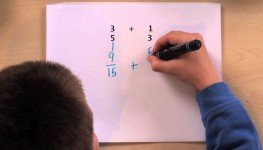Academics
Careers
Overview of Grade 5 Common Core Mathematics
NWEA MAP Math Games by RIT Range
Khan Academy Resources Aligned to NWEA RIT Scores
(Ask your child's teacher for his/her NWEA RIT.)



What Your Child Will Learn
Standard
Understand multi-digit place value (5.NBT.1)
Multiply and divide by powers of 10 (5.NBT.2)
Read, write and compare decimals to the thousandths (5.NBT.3)
Round decimals to any place (5.NBT.4)
Fluently multiply multi-digit whole numbers using the standard algorithm (5.NBT.5)Divide multi-digit numbers (5.NBT.6)
Add, subtract, multiply and divide decimals to the hundredths (5.NBT.7)
What Does It Mean?
What Does It Look Like?
Vocabulary
Decimal: A number that uses place value and a decimal point to show values less than one, such as tenths and hundredths
Place Value: The value of a digit in a number
Standard Algorithm: A way of setting out a step-by-step mathematical procedure
Rounding: To find the nearest ten, hundred, or thousand (and so on). For example, 391 rounds up to 400 and 331 rounds down to 300
Digit: A symbol used to show a number
Power of 10: When one of the factors is a multiple of ten, you can use place value patterns and basic facts to find the product
Product: The result (answer) of multiplying a set of numbers together.
Quotient: The result (answer) of dividing two numbers.
Estimate: To find a number close to an exact amount.
Operations: Addition, Subtraction, Multiplication, Division
Activities At Home
Create number cubes or spinners and have the student identify the place value and value of different digits in that number.
Roll or pick numbers to create decimals. Add, subtract, multiply, or divide the decimals.
Find the batting averages or other statistics in the sports section of a newspaper and add or subtract the statistics.
Estimate and find the sums and differences of items at the store and in restaurants.
Practice basic addition, subtraction, multiplication and division facts.
Roll or pick numbers to create decimals. Compare and order the numbers.
Choose a four-digit number. Multiply and divide by powers of 10 (10, 100, 1,000, etc.) by moving the decimal point left or right as appropriate.
Learning Links
2 Digit Multiplication
Calculator Chaos
Equivalent Numbers
Rounding Decimals Tutorial NBT.4
Finding Numbers on a Hundreds Chart
Place Value
What Your Child Will Learn
Standard
Add and subtract fractions with unlike denominators, including mixed numbers (5.NF.1)
Solve addition and subtraction word problems with fractions (5.NF.2)
Solve word problems, understanding that fractions can also be a representation of a division problem
whereas the denominator needs to be divided into a numerator (a/b = a ÷ b) (5.NF.3)
Interpret a fraction as division of the numerator by the denominator (for example, interpret 3/4 as the result of dividing 3 by 4)
Divide fractions to solve word problems (for example, For example, 3 wholes are shared equally among 4 people each person has a share of size ¾)
Multiply a fraction by a whole number and other fractions (5.NF.4)
Understand the relationship between the size of the product and the size of the factors (5.NF.5)
Multiply fractions to solve word problems (5.NF.6)
Divide unit fractions by whole numbers and divide whole numbers by unit fractions (5.NF.7)
What Does It Mean?
What Does It Look Like
Vocabulary
Denominator: The number below the line in the fraction. The denominator represents the number of equal pieces the whole is broken into
Mixed Number: A number that is made up of a whole number and a fraction
Numerator: The number above the line in a fraction. The numerator represents how many pieces of the whole, or how many parts of a set, that are discussed
Product: The result (answer) of multiplying a set of numbers together
Factor: A number that is multiplied by another (factor x factor = product)
Equivalent Fractions: Two or more fractions with the same value. Example: 1/2 = 2/4
Improper Fractions: A fraction where the numerator is greater than the denominator.
Activities At Home
Create or pick numbers to make fractions. Add, subtract, or simplify the fractions that you find.
Find examples of fractions around the house or neighborhood. Add, subtract, multiply, divide or simplify the fractions that you find.
Create numbers to use in fractions. Draw these fractions as parts of a whole or set.
Use measuring cups when baking or cooking.
Identify the use of decimals in sporting events and in newspapers.
Draw different shapes. Divide them into different fractions.
Practice multiplication and division facts.
Learning Links
What Your Child Will Learn
Use parenthesis, brackets or braces in numerical expressions (5.OA.1)
Write and understand equations without solving for them (5.OA.2)
Use number patterns to solve equations involving input/output machines (5.OA.3)
StandardWhat Does It Look Like?
What Does It Mean?
Vocabulary
Ordered pairs: A pair of numbers where order is important, (4,6) is different to (6,4). Often used to indicate on a coordinate plane, graph, or map.
Coordinates: Shown as pairs of letters and/or numbers, e.g. (2,4). Used to show position on a coordinate plane or map.
Patterns: A sequence of shapes or numbers that follow a logical rule.
Function: A mathematical relationship between two values. The second value depends on (is a function of) the first one.
Expression: A mathematical combination of numbers, variables, and operations.
Equation: A number sentence with an equal sign. 5 x 4 = 20.
Activities At Home
Make up numbers, roll numbers with dice, or find numbers (on labels) and compare them.
Create rules (ex. n = 3) and have your student extend the number pattern (3, 6, _ , _).
Create a number pattern and have your student write the rule.
Create an input/ output machine (function table) for a given rule and have the student fill in the missing Inputs and Outputs.
Create an input/ output machine (function table) for an unknown rule and have the student fill in the missing Inputs and Outputs and write the rule.
Find numbers and write them in expanded form.
Draw pictures and make models of numbers.
Practice addition, subtraction, multiplication and division facts.
Online Learning Links
Calculator Chaos
Math SearchOrder of Operations
Number Cracker
Math Scramble
Weigh the Wangdoodles
What Your Child Will Learn
Convert measurements using like units and use these conversions in multi-step word problems (5.MD.1)
Make a line plot to display a data set of measurements in fractions of a unit (5.MD.2)
Understand the concept of volume as a measurement of solid and liquid objects
(5.MD.3)
Find volume using the formula (5.NBT.4)
Add and multiply to solve volume problems (5.NBT.5)
StandardWhat Does It Look Like?
What Does It Mean?
Vocabulary
Volume: The amount of space that a three-dimensional figure contains. Volume is expressed in cubic units, (how many small cubes would fit inside a solid figure).
Three-Dimensional Figure: A measure in three directions, such as length and width.
Line Plot: A number line long enough to encompass all numbers in the sample, showing a dot or mark over the position corresponding to each number.
Mass: A measure of how much matter is in an object.
Capacity: How much liquid a container can hold (see volume).
Rectangular Prism: A prism with two identical, rectangular bases.
Rectangle: A quadrilateral with four right angles and two pairs of opposite equal parallel sides.
Right Prism: A solid three-dimensional with two identical, parallel bases. All other faces are rectangles.
Base: A side of a polygon or a face of a solid figure by which the figure is measured or named.
Activities At Home
Make flash cards of different geometric figures and their properties.
Identify different plane and solid figures in your environment.
Find the volume of real-world objects in your home.
Make nets for different solid figures using graph paper. Compare nets that work to nets that do not fold correctly to make the figures.
Compare the estimated volume of a carton or bottle of liquid (such as 1/2 gallon juice or milk or two liter bottle of lemonade) in cubic inches or centimeters to its stated volume in ounces or milliliters.
Learning Links
Maximum Capacity
Matching Math
Minecraft Volume
Matching Math
Create a Graph